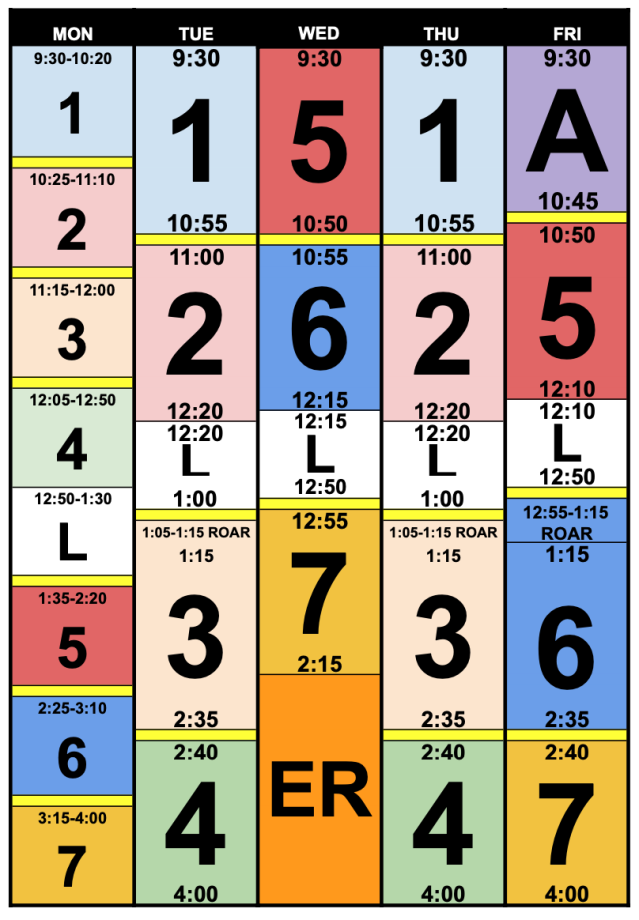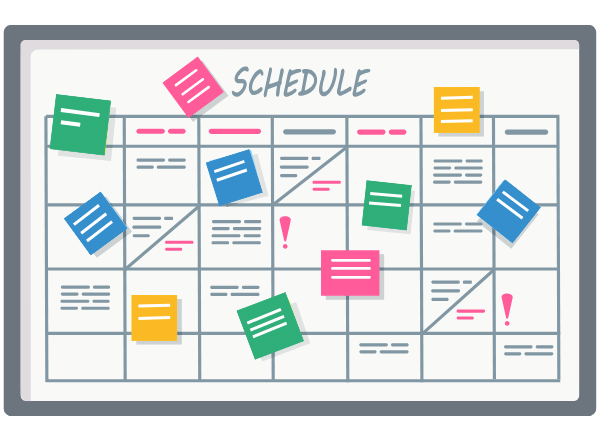A schedule is a plan that organizes tasks by time. It helps manage activities and achieve goals efficiently.
Creating a schedule can significantly boost productivity. Whether you’re balancing work, school, or personal projects, a well-structured schedule is key. It helps prioritize tasks, reduces stress, and ensures you stay on track. With a clear plan, you’ll know what to do and when to do it.
This can save time and prevent last-minute rushes. Schedules also provide a sense of control and accomplishment. By following a schedule, you can break down big tasks into smaller, manageable steps. This makes projects seem less daunting and more achievable. Let’s explore how to create an effective schedule that works for you.

Credit: www.pediatricare.com
Importance Of Scheduling
Scheduling is a powerful tool. It helps manage time, set priorities, and achieve goals. Sticking to a schedule provides structure. It ensures tasks are completed on time. Understanding the importance of scheduling can transform your daily life. It boosts productivity and reduces stress. Let’s explore these benefits in detail.
Boosting Productivity
Scheduling boosts productivity. It helps prioritize tasks. You can focus on what matters most. Breaking tasks into smaller steps makes them manageable. Completing small tasks builds momentum. It motivates you to keep going. Scheduled breaks prevent burnout. They help maintain high energy levels. A well-planned schedule can double your efficiency.
Reducing Stress
Scheduling reduces stress. It provides a clear plan for the day. Knowing what to expect eases anxiety. It reduces the fear of the unknown. A schedule helps balance work and personal life. It ensures time for relaxation. You can avoid last-minute rushes. This leads to a more relaxed mindset. It improves overall mental health.
Setting Priorities
Setting priorities helps you manage time effectively. Knowing what tasks are most important can lead to better productivity. It avoids the stress of missed deadlines. You can focus on what truly matters.
Identifying Key Tasks
Identify key tasks by listing everything you need to do. Then, rank them based on importance and urgency. This helps you see what requires immediate attention. Separate tasks that can wait from those that cannot.
Ask yourself if a task impacts your goals directly. Tasks that move you closer to your goals should be prioritized. Consider the deadlines of each task. Those with sooner deadlines often need immediate action.
Using The Eisenhower Matrix
The Eisenhower Matrix is a tool to organize tasks. It divides tasks into four categories: urgent and important, important but not urgent, urgent but not important, and neither urgent nor important.
Start with tasks that are urgent and important. These tasks need immediate attention. Next, focus on important but not urgent tasks. Plan time for these tasks to avoid last-minute rushes.
Urgent but not important tasks can be delegated. If possible, assign them to someone else. Tasks that are neither urgent nor important can be eliminated. They often waste time and do not add value.
Time Blocking
Ever feel like your day is a whirlwind of tasks and you just can’t keep up? You’re not alone. Many people struggle to manage their time effectively. But there’s a simple technique that can help: Time Blocking. This method can transform your chaotic schedule into a well-organized plan. Let’s dive into the details.
What Is Time Blocking?
Time Blocking is a time management method where you divide your day into blocks or chunks. Each block is dedicated to a specific task or group of tasks. Think of it as scheduling appointments with yourself. Instead of a never-ending to-do list, you have a structured plan. You know exactly what to focus on and when.
Imagine your day is a puzzle. Time Blocking helps you fit all the pieces together. You can allocate time for work, family, hobbies, and even relaxation. It’s like giving each activity its own special time slot. This way, you avoid multitasking and stay focused.
Benefits Of Time Blocking
Time Blocking offers numerous benefits. Here are some of the key advantages:
- Increased Productivity: By focusing on one task at a time, you can complete it faster and with better quality.
- Reduced Stress: Knowing what you need to do and when to do it can lower anxiety and overwhelm.
- Better Time Management: You can see where your time goes and make adjustments as needed.
- Improved Focus: With fewer distractions, you can concentrate more effectively on the task at hand.
Personally, I’ve found Time Blocking to be a game-changer. Before using this method, my days felt scattered. I was always chasing deadlines and feeling frazzled. But now, I have a clear plan and can tackle my tasks with confidence. It’s like having a roadmap for my day.
So, why not give Time Blocking a try? It might just be the secret to a more organized and productive life. And who doesn’t want that?

Credit: www.sfusd.edu
Creating A Daily Routine
Creating a daily routine can help structure your day. It makes tasks easier to manage. You know what to expect. This improves your productivity. A routine also reduces stress. You won’t waste time thinking about what to do next. Let’s explore how to build one.
Morning Routines
Start your day with a plan. Wake up at the same time each morning. This sets a steady rhythm for your body. After waking up, make your bed. It gives you an instant sense of achievement. Next, hydrate yourself. Drink a glass of water to kick-start your system.
Consider a brief exercise session. It could be stretching, yoga, or a short walk. Physical activity boosts your energy levels. Follow this with a healthy breakfast. Choose foods that keep you full and energized. Think oatmeal, fruits, or eggs.
Finally, list your tasks for the day. Prioritize them. Focus on the most important ones first. This helps you stay organized and on track.
Evening Routines
Wind down your day with a calming routine. Set a fixed time to stop working. This helps you separate work from personal time. Engage in a relaxing activity. Read a book, listen to music, or take a warm bath.
Prepare for the next day. Lay out your clothes. Pack your bag. This saves time in the morning. Reflect on your day. Think about what went well. What could be better? This helps you improve over time.
Avoid screens an hour before bed. Blue light from screens can disrupt your sleep. Instead, try reading a physical book. Also, set a regular bedtime. Consistent sleep is key to feeling refreshed.
Using Productivity Tools
In today’s busy world, finding the right tools to manage your schedule can be a game-changer. Productivity tools are like your personal assistants, helping you stay on top of tasks, meetings, and deadlines. Whether you’re a digital enthusiast or a fan of traditional methods, there’s something for everyone. Let’s explore how you can make the most out of productivity tools.
Digital Tools
In the age of technology, digital tools are a popular choice for managing schedules. They offer a range of features that can simplify your life. Here are a few that you might find useful:
- Google Calendar: This is a free tool that syncs across all your devices. You can set reminders, schedule meetings, and even share your calendar with others.
- Trello: Trello uses boards, lists, and cards to help you organize tasks. It’s great for visual thinkers and those who need to manage multiple projects.
- Todoist: Todoist is a simple yet powerful task manager. It helps you keep track of your to-do list with ease.
These tools are user-friendly and can be accessed from anywhere, making them perfect for people on the go. Personally, I’ve found Google Calendar to be a lifesaver. It sends me reminders for everything, from meetings to grocery shopping. Who knew a calendar could be so helpful?
Analog Tools
Not everyone is a fan of digital tools. Some people prefer the old-school charm of pen and paper. Analog tools can be just as effective and sometimes even more satisfying. Let’s look at a couple of options:
- Bullet Journal: A bullet journal is a customizable planner. You create your own system of organization, which can be as simple or as detailed as you like.
- Planner Notebooks: These are pre-printed planners that come with sections for daily, weekly, and monthly planning. They often include spaces for notes and goals.
Analog tools offer a tactile experience that many people find rewarding. Writing things down by hand can improve memory and focus. I remember using a bullet journal during my college years. The satisfaction of crossing off tasks was unmatched!
In conclusion, whether you prefer digital or analog tools, the key is to find what works best for you. Experiment with different options and see which one fits your lifestyle. Happy scheduling!
Avoiding Multitasking
Multitasking might seem like a superpower, but it can actually harm productivity. Juggling multiple tasks often leads to mistakes and stress. Instead, focusing on one task at a time can improve efficiency and overall performance. Let’s explore some strategies to avoid multitasking and make your schedule work better for you.
Focus On Single Tasks
Imagine trying to juggle five balls at once. It sounds tough, right? It’s the same with tasks. When you focus on one task, you can do it better and faster. Here are some tips:
- Prioritize: Choose the most important task first. Do it with full attention.
- Set Time Blocks: Allocate specific times for each task. Stick to these time blocks.
- Take Breaks: After finishing a task, take a short break. This helps you stay fresh.
Handling Distractions
Distractions are everywhere. They can be a ringing phone, social media, or even our own thoughts. Handling these distractions is key to staying focused. Here’s how you can manage them:
| Distraction | Solution |
|---|---|
| Phone Calls | Turn off notifications during work time. |
| Social Media | Use apps that block social media sites. |
| Noise | Wear noise-canceling headphones or find a quiet place. |
It’s also helpful to create a distraction-free environment. Keep your workspace tidy and only have the things you need for your current task. This makes it easier to stay focused and get things done.
Remember, avoiding multitasking is not just about doing less. It’s about doing things better. By focusing on single tasks and handling distractions, you can improve your productivity and reduce stress. Give it a try and see how your schedule improves!
Incorporating Breaks
Taking breaks is important for a healthy schedule. It helps you stay focused and productive. Regular breaks can reduce stress and prevent burnout. Let’s explore two effective ways to incorporate breaks into your schedule.
Pomodoro Technique
The Pomodoro Technique is a popular time management method. It involves working for 25 minutes, then taking a 5-minute break. After four cycles, take a longer break of 15-30 minutes. This method helps maintain concentration. The short breaks keep your mind fresh.
Importance Of Downtime
Downtime is crucial for recharging your mind and body. It allows you to relax and recover. This leads to better performance and creativity. Taking regular breaks helps you avoid fatigue. It also improves your overall well-being. Make sure to schedule downtime in your day. Even short breaks can make a big difference.

Credit: www.planningpme.com
Reviewing And Adjusting Schedules
Reviewing and adjusting schedules can be a game-changer in managing your time more effectively. It’s not just about marking tasks off your to-do list, but about making real-time changes to ensure you stay on track. Let’s talk about how you can review and adjust your schedule daily and weekly to make the most out of your time.
Daily Reviews
Every day is a new opportunity to refine your schedule. It’s not about making huge changes; small tweaks can make a big difference. Here’s how you can do it:
- Morning Check-In: Start your day by reviewing your schedule. Look at your tasks and see if they are still relevant. If something new has come up, adjust your schedule accordingly.
- Midday Review: Take a few minutes during lunch to see how you’re doing. Are you on track? If not, prioritize the most important tasks for the afternoon.
- End-of-Day Reflection: Before you wrap up for the day, review what you’ve accomplished. Move any unfinished tasks to the next day’s schedule and plan for tomorrow.
Weekly Reviews
While daily reviews help you stay on top of your tasks, weekly reviews give you the bigger picture. Here’s how to make your weekly reviews effective:
- Set Aside Time: Choose a specific time each week to review your schedule. Sunday evenings work well for many people.
- Analyze Your Week: Look back at what you accomplished. Did you meet your goals? If not, why? Understanding this can help you make better plans for the next week.
- Adjust and Plan: Based on your analysis, adjust your schedule for the upcoming week. Make sure to include any new tasks or priorities.
Remember, the goal of reviewing and adjusting your schedule is to make your life easier, not harder. Regular reviews help you stay flexible and adapt to changes. So, start making these small adjustments and see how they can improve your productivity and peace of mind. And hey, don’t forget to take a break once in a while – you deserve it!
Frequently Asked Questions
What Do You Mean By A Schedule?
A schedule is a planned timetable outlining tasks, events, or activities. It helps manage time and ensures organization.
Is It Schedule Or Skedule?
The correct spelling is “schedule. ” “Skedule” is incorrect. Use “schedule” for professional and formal writing.
Is Schedule Correct Spelling?
Yes, “schedule” is the correct spelling. It refers to a plan for carrying out a process or procedure.
How Do Americans Pronounce Schedule?
Americans pronounce “schedule” as “sked-jool. ” The “sch” sounds like “sk” and the “dule” sounds like “jool. “
Conclusion
Creating a schedule can boost your productivity and reduce stress. A well-planned day helps you stay focused. You can achieve more by organizing your tasks. Remember to be flexible. Life can be unpredictable. Adjust your schedule as needed. Small changes can make a big difference.
Start with simple steps. Soon, managing time will feel natural. Stick to your plan. Watch how your efficiency improves. Happy scheduling!






